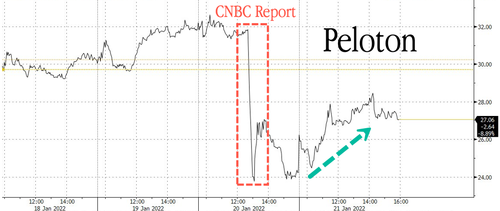Key Events This Week: FOMC, GDP, Core PCE, And Earnings Galore
Given the tough last week for the markets, which saw the Nasdaq 100 do something it hasn’t done since the aftermath of the internet bubble, when it fell more than 1% in every session of a week, this week brings a fascinating double header. Not only do we have the FOMC on Wednesday but we have some notable tech earnings in the form of Apple (Thursday), Tesla (Wednesday) and Microsoft (Tuesday). As DB’s Jim Reid notes, “plenty of scope for market moving info.”
Digging into this week’s details, we’ll get a first look at how the global economy has fared into the new year (and with Omicron) with the release of the January flash PMIs today. Japan’s Jibun Bank manufacturing PMI edged up to +54.6 overnight, the highest in at least three years from +54.3 in December. However, the survey also showed that the nation’s service sector activity contracted in January for the first time in four months, from +46.6 versus +52.1 in December, as Omicron hit. Returning to the week ahead we’ll also look back a bit with the Q4 GDP releases from the US (Thursday), France and Germany (both Friday) as well. Keep an eye out for the initial jobless claims from the US as well, since they’ve deteriorated in recent weeks and that’s one of the most timely indicators we get on the state of the labour market there. The weakness is likely Omicron related and given its on the retreat again this may be temporary. There’ll also be plenty of political developments to look out for as well, including the Italian Presidential election. Geopolitics doesn’t always impact markets even if they feel very tense and fraught. However the current Russia/Ukraine situation does seem to be adding to the risk off at the moment and merits close attention.
As discussed at the top, the main market highlight this week will be the Federal Reserve’s first monetary policy decision of the year on Wednesday, along with Fed Chair Powell’s subsequent press conference. According to our economists, this January meeting is set to be the last before they kick off that hiking cycle, with lift-off set to commence in March as part of the first of 4 hikes this year. However, they’ve also argued (link here) that there’s a tail risk of an even bigger hawkish surprise over the months ahead, with the possibility that the Fed raises rates in March and then goes onto raise rates 6 or 7 times this year. So maybe the calm before the storm. Also watch out to see if the committee want to outline more of their current QT plans. The Q&A could be a popcorn moment for the markets with plenty of questions likely on inflation, the Fed’s hiking path, financial conditions and QT amongst other things.
On the earnings side, the season really ramps up this week, with a number of US Tech companies reporting in particular. In total, we’ve got 106 companies in the S&P 500, along with a further 46 in the STOXX 600 so there’s plenty to look out for. Among the highlights are IBM today. Then tomorrow we’ll hear from Microsoft, Johnson & Johnson, Verizon Communications, NextEra Energy, Texas Instruments, American Express, General Electric and Moderna. On Wednesday, releases will include Tesla, Abbott Laboratories, Intel, AT&T and Boeing. Thursday then sees reports from Apple, Visa, LVMH, Mastercard, Comcast, Danaher, McDonald’s, SAP, UniCredit and Samsung Electronics. Finally on Friday, we’ll hear from Chevron and Caterpillar.
Turning to the political scene, there are a number of events expected this week. First, there’s the Italian Presidential election, with the Italian parliament and regional delegates set to start voting today. If a president is not elected in the first round of voting, another vote will take place tomorrow, with a vote normally taking place each day until a President has been selected. Since the approval of the Constitution in 1948, it’s taken 9 votes on average over 6 days to elect the President. In the first three rounds, a two-thirds majority is required, but from the fourth round only an absolute majority is needed.
Otherwise, there’ll be a lot of attention on the UK this week, where it’s expected that the long-awaited report by the civil servant Sue Gray will be released looking at allegations of parties having taken place in Downing Street during the pandemic. There isn’t a confirmed date for this yet, but it’s expected to arrive some time this week. Against this backdrop, there has been growing speculation that a vote of no confidence could be called in Prime Minister Johnson’s leadership of the Conservative Party, which will take place if 15% of Conservative MPs submit a letter of no confidence. Some Conservative MPs have already said publicly that they have submitted a letter, and if a vote then took place, it would be a secret ballot among Conservative MPs where a simple majority would then be required to remove Johnson as leader. Brexit will also remain in the headlines, as EU Commission Vice President Maroš Šefčovič will be meeting again with UK Foreign Secretary Liz Truss on Monday regarding the Northern Ireland Protocol. Finally in the UK, there’ll be a further easing of Covid-19 restrictions in England, as from Thursday there will be an end to the requirement for Covid passes at large events, and face coverings will no longer be legally required in any setting.
Elsewhere tomorrow, the IMF will be releasing their latest forecasts for economic growth around the world, with their World Economic Outlook update. These normally generate a few headlines.
Courtesy of DB, here is a day-by-day calendar of events
Monday January 24
- Data: January flash manufacturing, services and composite PMIs from Japan, France, Germany, Euro Area, UK and US, US December Chicago Fed national activity index
- Earnings: IBM
Tuesday January 25
- Data: Germany January Ifo business climate indicator, US November FHFA house price index, January Conference Board consumer confidence, Richmond Fed manufacturing index
- Central Banks: Bank of Japan release Summary of Opinions from January meeting (23:50 UK time)
- Earnings: Microsoft, Johnson & Johnson, Verizon Communications, NextEra Energy, Texas Instruments, American Express, General Electric, Moderna
- Other: IMF release World Economic Outlook Update
Wednesday January 26
- Data: US preliminary December wholesale inventories
- Central Banks: Monetary policy decisions from the Federal Reserve and Bank of Canada
- Earnings: Tesla, Abbott Laboratories, Intel, AT&T, Boeing
Thursday January 27
- Data: China December industrial profits, Germany February GfK consumer confidence, US weekly initial jobless claims, preliminary December durable goods orders, core capital goods orders, Q4 GDP, December pending home sales, January Kansas City Fed manufacturing activity
- Central Banks: Monetary policy decision form the South African Reserve Bank, ECB’s Scicluna speaks
- Earnings: Apple, Visa, LVMH, Mastercard, Comcast, Danaher, McDonald’s, SAP, UniCredit, Samsung Electronics
Friday January 28
- Data: France preliminary Q4 GDP, December PPI, Germany preliminary Q4 GDP, Euro Area December M3 money supply, final January consumer confidence, Italy January consumer confidence, US December personal income, personal spending, final January University of Michigan consumer sentiment index
- Earnings: Chevron, Caterpillar
* * *
Finally, looking at just the US, Goldman writes that the key economic data releases this week are the Q4 GDP release, durable goods report, and jobless claims on Thursday, as well as the core PCE inflation report and employment cost index release on Friday. The January FOMC meeting is this week, with the release of the statement at 2:00 PM ET on Wednesday, followed by Chair Powell’s press conference at 2:30 PM. There are no other scheduled speaking engagements by Fed officials this week.
Monday, January 24
- 09:45 AM Markit Flash US manufacturing PMI, January preliminary (Bloomberg consensus 56.7, last 57.7)
- Markit Flash US services PMI, January preliminary (consensus 54.8, last 57.6)
Tuesday, January 25
- 09:00 AM FHFA house price index, November (consensus 1.1%, last 1.1%)
- 09:00 AM S&P/Case-Shiller 20-city home price index, November (GS +0.9%, consensus +0.97%, last +0.92%); We estimate the S&P/Case-Shiller 20-city home price index rose by 0.9% in November, following a 0.92% increase in October.
- 10:00 AM Conference Board consumer confidence, January (GS 112.5, consensus 111.8, last 115.8); We estimate that the Conference Board consumer confidence index decreased by 3.3pt to 112.5 in January, reflecting negative signals from other confidence measures.
- 10:00 AM Richmond Fed manufacturing index, January (consensus 14, last 16)
Wednesday, January 26
- 08:30 AM Advance goods trade balance, December (GS -$96.0bn, consensus -$96.0bn, last -$98.0bn): We estimate that the goods trade deficit decreased by $2.0bn to $96.0 in December compared to the final November report, reflecting an increase in imports.
- 08:30 AM Wholesale inventories, December preliminary (consensus 1.4%, last 1.4%): Retail inventories, December (consensus 1.5%, last 2.0%)
- 10:00 AM New home sales, December (GS +2.0%, consensus +2.8%, last +12.4%): We estimate that new home sales increased by 2.0% in December, reflecting softer housing permits, starts, and mortgage applications relative to November.
- 02:00 PM FOMC statement, January 25-26 meeting: As discussed in our FOMC preview, we expect that the FOMC will use this meeting to hint at a March liftoff and begin formulating a plan for balance sheet reduction. We expect the FOMC to raise interest rates four times this year starting in March and to announce the start of balance sheet reduction in July.
Thursday, January 27
- 08:30 AM Initial jobless claims, week ended January 22 (GS 295k, consensus 260k, last 286k); Continuing jobless claims, week ended January 15 (consensus 1,650k, last 1,635k): We estimate initial jobless claims increased to 295k in the week ended January 22.
- 08:30 AM GDP, Q4 advance (GS +6.5%, consensus, +5.3%, last +2.3%); Personal consumption, Q4 advance (GS +3.2%, consensus +2.9%, last +2.0%): We estimate GDP growth picked up to +6½% annualized in the advance reading for Q4, following +2.3% in Q3. Our forecast reflects firming consumption growth (to +3.2%), with Omicron reducing activity only very late in the quarter. We expect lackluster growth in business structures and equipment investment—but expect a strong gain in the intellectual property category (+7%). We estimate a boost to GDP growth from inventories (+3.2pp qoq ar) but a drag from net trade (-1.4pp).
- 08:30 AM Durable goods orders, December preliminary (GS -1.0%, consensus -0.5%, last +2.6%); Durables goods orders ex-transportation, December preliminary (GS +0.4%, consensus +0.3%, last +0.9%); Core capital goods orders, December preliminary (GS +0.4%, consensus +0.3%, last flat); Core capital goods shipments, December preliminary (GS +0.5%, consensus +0.4%, last +0.3%): We estimate durable goods retrenched 1.0% in the preliminary December report, reflecting a pullback in commercial aircraft and defense orders. We expect firm gains in core capital goods orders (+0.4%) and core capital goods shipments (+0.5%), reflecting strong goods demand and higher prices.
- 10:00 AM Pending home sales, December (GS -1.5%, consensus +0.5%, last -2.2%): We estimate that pending home sales decreased by 1.5% in December. Existing home sales are an input into the brokers’ commissions component of residential investment in the GDP report.
- 11:00 AM Kansas City Fed manufacturing index, January (consensus 19, last 24)
Friday, January 28
- 08:30 AM Employment cost index, Q4 (GS +1.1%, consensus +1.2%, prior +1.3%): We estimate that the employment cost index rose 1.1% in Q4 (qoq sa), which would boost the year-on-year rate by four tenths to +4.1%. Labor shortages continued to exert upward pressure on wage growth in the fourth quarter, though we expect a sequentially slower pace of ECI benefit growth after a jump in Q3.
- 08:30 AM Personal income, December (GS +0.6%, consensus +0.5%, last +0.4%); Personal spending, December (GS -0.7%, consensus -0.6%, last +0.6%); PCE price index, December (GS +0.37%, consensus +0.4%, last +0.61%); Core PCE price index, December (GS +0.40%, consensus +0.5%, last +0.46%); PCE price index (yoy), December (GS +5.72%, consensus +5.8%, last +5.73%); Core PCE price index (yoy), December (GS +4.77%, consensus +4.8%, last +4.68%): Based on details in the PPI, CPI, and import price reports, we forecast that the core PCE price index rose by 0.40% month-over-month in December, corresponding to a 4.77% increase from a year earlier. Additionally, we expect that the headline PCE price index increased by 0.37% in December, corresponding to a +5.72% increase from a year earlier. We expect that personal income increased by 0.6% and personal spending decreased by 0.7% In December.
- 10:00 AM University of Michigan consumer sentiment, January final (GS 70.0, consensus 68.8, last 68.8): We expect the University of Michigan consumer sentiment index increased by 0.2pt to 70.0 in the final January reading.
Source: Deutsche Bank, Goldman, BofA.
Tyler Durden
Mon, 01/24/2022 – 09:34
via ZeroHedge News https://ift.tt/3KOLWFk Tyler Durden















